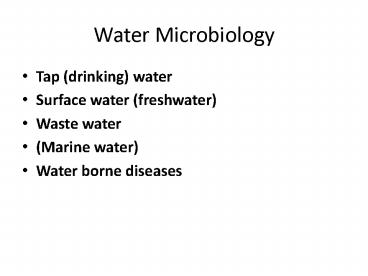Water Microbiology - PowerPoint PPT Presentation
1 / 31
Title:
Water Microbiology
Description:
Water Microbiology Tap (drinking) water Surface water (freshwater) Waste water (Marine water) Water borne diseases Tap water (drinking water) Optimum = no ... – PowerPoint PPT presentation
Number of Views:464
Avg rating:3.0/5.0
Title: Water Microbiology
1
Water Microbiology
- Tap (drinking) water
- Surface water (freshwater)
- Waste water
- (Marine water)
- Water borne diseases
2
Tap water (drinking water)
- Optimum no microorganisms
- Microbial quality determination
- Faecal coliforms, Escherichia coli indicator of
fresh faecal contamination (cultivation 43C) - Coliforms - indicator of total faecal
contamination (includes faecal coliforms)
total coliforms
3
Tap water (drinking water)
- Enterococci the third indicator of faecal
contamination (metabolically LAB) - Mesophiles temperature optimum 20-45C,
sources soil, faeces, plant. (EU CFU at 36C) - Psychrophiles - temperature optimum lt20C, often
autochthonous water microflora source soil (EU
CFU at 22C)
4
Tap water (drinking water)
- Clostridium perfringens potentially pathogenic,
quality indicator for processing from surface
water - Pseudomonas aeruginosa - potentially pathogenic,
(CR bottled water) - Disinfection Ag, Cl, O3, UV radiation
5
MICROBIOLOGICAL STANDARDS FOR DRINKING WATER
- Total plate counts
- lt 200 cfu/ml at 22oC
- lt 100 cfu/ml at 36oC
- E. coli, coliforms
- Absence from 100 ml
- Enterococci (faecal streptococci)
- Absence from 100 ml
- Nitrates (NO3-)
- lt 50 mg/l (adults)
- lt 15 mg/l (infants)
6
Surface water (freshwater)
- Regularly contaminated
- Number of bacteria very fluctuable
- 10 109 /ml
- Plankton communities in water (bacterioplankton
zooplankton phytoplankton
7
Surface water (freshwater)
- Saprobity the level of surface water quality,
determined by - Organic matter content
- Density of microorganisms
- Character of processes (aerobic, anaerobic)
- Level of solved oxygen
- Biological oxygen demand (BOD)
8
Surface water (freshwater)
- Oligotrophic water
- no organic mater,
- low (no) number of microorganisms close to
drinking water, - fully saturated with oxygen,
- aerobic processes,
- good water for plenty organisms
9
Surface water (freshwater)
- Eutrophic (polysaprobic)
- very high level of organic mater, very high
microorganisms number , nearly no oxygen, - anaerobic processes,
- nearly no higher organisms
- Mesotrophic (mesosaprobic) medium level of
contamination and others factors, water
acceptable for several organisms
10
(No Transcript)
11
(No Transcript)
12
(No Transcript)
13
Biofilm formation
14
Marine Water A High Pressure Refrigerator
15
(No Transcript)
16
(No Transcript)
17
(No Transcript)
18
Wastewater Treatment
Wastewater Treatment Plant
Figure 11A. Generalized plan of a secondary sewage treatment plant using either (or both) an ACTIVATED SLUDGE or a TRICKLING FILTER SYSTEM. Note the direction of flow of the various sludges and effluents. If you can draw this plan from memory and describe what each component's purpose is, you qualify for the SEWAGE EXPERT gold star and will surely score well on the final exam.
19
Wastewater Treatment
Activated sludge tank
Trickling filter system
20
(No Transcript)
21
Aerobic Degradation of Biodegradable Organic
Matter (BOM)
- aerobic microbes
- BOM CO2,
nitrate,sulphate, phophate (mineralization)
22
(No Transcript)
23
(No Transcript)
24
(No Transcript)
25
(No Transcript)
26
(No Transcript)
27
Water Borne Diseases
- Cholera (Vibrio cholerae), enterotoxin, diarrhea,
oral rehydration therapy - Salmonelosis (Salmonella enterica Enteritidis)
- Shigellosis (Shigella dysenteri)
- Travelers diarrhea (Escherichia coli)
- Helicobacter pylori
- Hepatitis A long incubation period
28
Water Borne Diseases
- Legionella pneumophila
- Pseudomonas aeruginosa
- Hepatitis A long incubation period
- Giardia lamblia, G. Intestinalis, endemic in US
- Entamoeba histolytica
- Cyclospora cayetanenis
29
Summary of Water Borne Diseases
- WBDs are transmitted almost entirely true facal
contaminated water - Prevention proper sanitation procedures
(minimizing faecal pollution, washing hands,
traetment of polluted water)
30
Many rural areas in Cambodia show high rates of
waterborne and water related diseases
31
(No Transcript)































